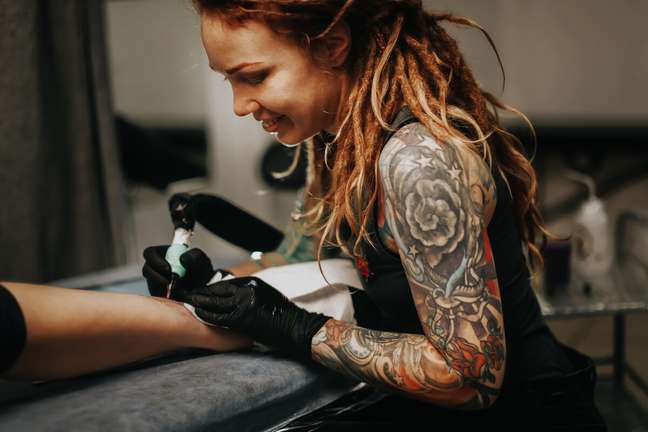Studies link the products to allergies, the induction of genetic mutations and even cancer; for specialists, the risks can be carefully reduced

For a long time, the use of non-sterile needles or even their reuse has been the main concern of health authorities and healthcare professionals when it comes to tattoo. More recently, the paints used for the procedures have entered even more on the radar of specialists, who seek to identify and minimize the potential damage caused by these products.
In January, the European Chemicals Agency (ECHA) restricted the use of more than 4,000 substances found in (mostly colored) tattoo inks and related to some type of health problem. Some examples are azo dyes, carcinogenic aromatic amines, polycyclic aromatic hydrocarbons (PAHs), metals And methanolrelated to allergies, irritation, induction of genetic mutations or cancer. According to the agency, the intention is not to ban tattoos, but to make the colors used in them safer.
Although the most serious concerns about pigments contained in inks are their carcinogenic potential and the possibility of causing changes in DNA, there is still no way to link these effects to products. “It is an application risk, they have toxic chemical properties and contain carcinogens. But in practice, we have no evidence that there is an association between the application of the paint and the appearance of cancer or if it is a coincidence,” he explains. the doctor. dermatologist Moyses Lemos.
A tattoo ink consists of two parts: the pigment and the carrier solution, which holds the substances together, makes the pigment more soluble and gives the product its consistency. The dermatologist points out that, “in general, paints have dozens of known allergens, metallic substances and organic pigments that remain relatively uncontrolled”. This is because allergic reactions to pigments, for example, can occur immediately or long after application, depending on the reaction of the immune system.
Another of the European Chemicals Agency’s considerations about the risks of tattoos is that, when removed with a laser, the substances in the ink are “broken” into smaller particles, which would release the harmful chemicals it contains. to circulate through the body and reach other tissues and organs, such as lymph nodes or the liver.
This possibility also attracted the attention of a group of researchers from the University of Binghamton (USA), who analyzed the components of different brands of paints sold in the American market.
In articles from 16 manufacturers, analyzed under electron microscopy, half had particles smaller than 100 nanometers, a size that was classified as “worrying” due to the risk of them crossing the cell membrane. According to the researchers, who presented findings at an American Chemical Society (ACS) meeting in late August, the components contained in the tattoo ink bottles are “a mystery.”
With nearly 100 paints analyzed, the study found that, in addition to the very small particles, many contained ingredients not listed on the label, such as ethanol, and 26 contained azo compounds (one of the types of substances restricted by the European Agency). The group of scientists reported that “surprisingly, no manufacturer produces specific pigments for tattoo inks.”
THE Food and Drug Administration (FDA)a regulatory agency in the United States similar to the National Health Surveillance Agency (Anvisa), consider these products a type of cosmetic. Therefore, the agency intervenes only in cases of the need to recall batches or contamination of products by microorganisms and declares that it does not exercise regulatory authority on the pigments used in paints – about 50 currently, on an ever-growing list.
The agency acknowledges that while there are dyes approved for use in cosmetics, none are approved to be injected into the skin. “Using an unapproved dye in a tattoo ink renders the ink adulterated. Many pigments used in tattoo inks are not approved for any type of skin contact. Some are industrial grade dyes suitable for printers or paints. for cars. “” states an FDA fact sheet on tattoos and permanent makeup.
Anvisa and regulation in Brazil
Brazilian legislation provides that equipment and inks used for tattoos must be registered with Anvisa. Today, there are 13 registered inks in the country. The agency informed that it follows discussions on the safety of tattoo inks in the European Union, but that in Brazil there is no list of prohibited pigments like that of ECHA.
The requirements for the authorization of Anvisa are foreseen by the RDC resolution 55 of 2008, which classifies the articles as “products used in the procedure of permanent artificial skin pigmentation” and tries to guarantee the absence of toxic or carcinogenic products among the components. sign in. , the pigments must comply with three resolutions of the Health Surveillance Agency (RDC 185/2001, RDC 546/2001 and RDC 553/2021).
The manufacturing or importing company must be regularized in the National Health Surveillance System (SNVS), have the authorization to operate for the activity (manufacturing or import) and comply with the good manufacturing practices provided for by the RDC resolution 665/2022 . To demonstrate product safety, biological assessment and risk management reports need to be submitted.
Based on the biological assessment, if Anvisa understands that biocompatibility tests – which assess the interaction of the substance with the body’s tissues – are required, the manufacturer must also provide them and submit their reports. The packaging labels, in turn, must contain the composition of the ink exactly as it has been evaluated and approved by Anvisa.
Is it possible to minimize the possible damage?
For Moyses Lemos, electronic media coordinator at the Brazilian Dermatology Society, the regulation represents additional security for tattoo artists and clients. “Of course, if you have an ink that follows the Anvisa authorization rules and within the validity period, you can trust a little more. But sure, you still have to take all possible precautions,” he says.
Among these precautions, biosafety specialist Esther Gawendo lists cleaning studies and stretchers with hospital disinfectants; hand sanitation; use of disposable materials such as needles, gloves and masks and use of hospital waste for infectious material such as blood. “The tattoo shop has to follow strict hygiene standards, almost like a medical clinic,” she explains. In addition, the tattoo artist must be vaccinated against diseases such as hepatitis B, C and D, covid-19 and tetanus.
Esther is president of the Tattoo do Bem organization, which aims to represent the professional interests of tattoo artists and piercers nationwide and has 1,200 members. She has a degree in Nursing, she teaches tattoo biosafety courses and is the CEO of Tattoo Week, a convention that brings together thousands of tattoo artists, piercers and exhibitors every year.
growing sector
According to data from Brazilian support service for micro and small businesses (Sebrae), the sector is growing by 25% a year and has more than 150,000 studios across the country. Esther believes that, as the area becomes more professional, the category seeks to invest more in safety. “The tattoo has become an important market, which generates income and jobs, and there is more concern in offering a quality service, based on safety standards and good practices. We have indications that at least 90% of Brazilian tattoo artists use inks. and presented to the Anvisa evaluation “, he reports.
During the University of Binghamton study that analyzed the composition of the ink brands, the researchers said they interviewed tattoo artists about their knowledge of the products their customers use. They quickly identified a favorite brand, but confessed that they didn’t know much about the components involved.
For Esther Gawendo, this type of knowledge is part of the baggage necessary to practice the profession: “It is the duty of the tattoo artist to know the product he uses and all its technical specifications”, he stresses.
Lemos adds color considerations to the list of treatments that can make tattoos safer. He states that the pigment responsible for the greatest number of allergic reactions is red and that red, orange and yellow paints are more likely to contain carcinogens. Blue, green, and silver also require attention, as they contain nickel, a metal often associated with jewelry allergies.
“As a dermatologist, I am against tattoos. But this is a personal thing, tattoos have been done for millennia. People have to take risks. The best thing, of course, would be to use only black pigment, if they choose to. Do it. the tattoo, “he explains.
More than an ancient art form, tattooing has acquired more practical applications. “Today we have safety tattoos for chronic patients (diabetic, hypertensive and allergic, for example), who use it to signal disease in the body itself. Thus, in the event of an accident or fainting, the rescuer knows that that person needs specific care “, exemplifies Esther Gawendo.
Other applications include scar coverage and visual reconstruction of eyebrows or nipples lost during cancer treatments, which can help re-signify and restore patients’ self-esteem.
Here are some tips to minimize the risks when getting a tattoo:
– Check if the ink used by the professional is registered with Anvisa and is within the expiration date;
– Check if the study falls within health surveillance standards;
– Observe whether the tattoo artist is aware of asepsis techniques, sterilizes the environment and uses disposable needles, gloves and mask;
– Avoid colors such as red, green, blue and silver, whose pigments are more likely to cause allergic reactions;
Follow the post-tattoo guidelines provided by the professional, which include avoiding foods with inflammatory potential, cleaning the tattooed body region, and avoiding exposure to sunlight.
Source: Terra
Benjamin Smith is a fashion journalist and author at Gossipify, known for his coverage of the latest fashion trends and industry insights. He writes about clothing, shoes, accessories, and runway shows, providing in-depth analysis and unique perspectives. He’s respected for his ability to spot emerging designers and trends, and for providing practical fashion advice to readers.






-qy1m7p1ozcqa.jpg)
